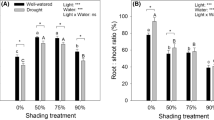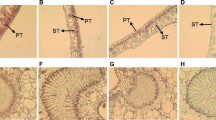Abstract
Key message
Shading could improve plant growth in Torreya grandis seedling, and 75 % shade is likely the optimum light irradiance level for its growth.
Abstract
Light is a critical factor that affects the survival and early growth of tree seedlings. Torreya grandis, an economically important subtropical plant, is a shade-preferring species; however, the optimum light intensity for the growth of this species was still unclear. To determine the optimum light intensity, we examined the growth, chlorophyll fluorescence, gas exchange, and chloroplast ultrastructure of T. grandis seedlings growing under four levels of shade (i.e., 0, 50, 75, and 90 %). The results showed that T. grandis attained the greatest Pn and biomass when cultivated with 75 % shade. Seedlings grown under 75 % shade exhibited a 155 % increase in the height increment, a 440 % increase in the diameter increment, a 42.2 % increase in biomass, and a 102 % increase in the photosynthetic rate compared with seedlings grown in full sun. Moreover, 75 % shaded plants had the lowest antioxidant enzyme activities, malondialdehyde content and ion leakage. Full sunlight and 50 % shade significantly reduced the growth of T. grandis which was associated with a decrease in the maximal photochemical efficiency, photosynthetic rate, chlorophyll content and biomass compared with those under 75 % shade. Compared with the 75 % shaded plants, seedlings grown under 90 % shade had a reduced photosynthetic rate, which was accompanied by increased malondialdehyde content, relative electrolyte conductivity and antioxidant enzymes activities, suggesting that seedlings under the 90 % shade had the lower energy utilizing capacity. Higher antioxidant enzyme activities might be an efficient adaptation to protection against oxidative stress under low light conditions. Therefore, our results indicate that 75 % shade is likely the optimum light irradiance level for T. grandis seedling growth.









Similar content being viewed by others
References
Adams WW III, Barker DH (1998) Seasonal changes in xanthophyll cycle-dependent energy dissipation in Yucca glauca Nuttall. Plant Cell Environ 21(5):501–511
Adriano S, Bartolomeo D, Cristos X, Andrea M (2004) Effects of different irradiance levels on some antioxidant enzymes and on malondialdehyde content during rewatering in olive tree. Plant Sci 166(2):293–302
Ai XZ, Guo YK, Ma XZ, Xing YX (2004) Photosynthetic characteristics and ultrastructure of chloroplast of cucumber under low light intensity in solar greenhouse. Scientia Agricultura Sinica 37(2):268–273 (in Chinese)
Aleric KM, Kirkman LK (2005) Growth and photosynthetic responses of the federally endangered shrub, Lindera melissifolia (Lauraceae), to varied light environments. Am J Bot 92(4):682–689
Allen RD (1995) Dissection of oxidative stress tolerance using transgenic plants. Plant Physiol 107(4):1049–1054
Alscher RG, Erturk N, Heath LS (2002) Role of superoxide dismutases (SODs) in controlling oxidative stress in plants. J Exp Bot 53(372):1331–1341
Anderson JM, Osmond CB (1987) Shade-sun responses: compromises between acclimation and photoinhibition. In: Kyle DJ, Osmond CB, Arntzen CJ (eds) photoinhibition. Elsevier Science Publishers, Amsterdam, pp 1–38
Asada K (1999) The water-water cycle in chloroplasts: scavenging of active oxygens and dissipation of excess photons. Annu Rev Plant Physiol Plant Mol Biol 50:601–639
Baker NR (2008) Chlorophyll fluorescence: a probe of photosynthesis in vivo. Annu Rev Plant Biol 59:89–113
Ben Ahmed C, Ben Rouina B, Sensoy S, Boukhriss M, Abdullah FB (2009) Saline water irrigation effects on antioxidant defense system and proline accumulation in leaves and roots of field-grown olive. J Agr Food Chem 57(24):11484–11490
Bertamini M, Muthuchelian K, Rubinigg M, Zorer R, Velasco R, Nedunchezhian N (2006) Low-night temperature increased the photoinhibition of photosynthesis in grapevine (Vitis vinifera L. cv. Riesling) leaves. Environ Exp Bot 57(1):25–31
Björkman O, Demmig B (1987) Photon yield of O2 evolution and chlorophyll fluorescence characteristics at 77 K among vascular plants of diverse origins. Planta 170:489–504
Chen BQ, Cui XY, Zhao X, Zhang YH, Piao HS, Kim JH, Yun YP (2006) Antioxidative and acute anti-inflammatory effects of Torreya grandis. Fitoterapia 77(4):262–267
Cheng XJ, Li ZJ, Yu WW, Dai WS, Fu QG (2007) Distribution and ecological characteristics of Torreya grandis in China. J Zhejiang For Coll 24(4):383–388 (in Chinese)
Critchley C (1998) Photoinhibition. In: Raghavendra AS (ed) Photosynthesis: A comprehensive Treatise. Cambridge University Press, Cambridge, pp 264–272
Dai Y, Shen Z, Liu Y, Wang L, Hannaway D, Lu H (2009) Effects of shade treatments on the photosynthetic capacity, chlorophyll fluorescence, and chlorophyll content of Tetrastigma hemsleyanum Diels et Gilg. Environ Exp Bot 65(2–3):177–182
Delagrange S, Montpied P, Dreyer E et al (2006) Does shade improve light interception efficiency? A comparison among seedlings from shade-tolerant and -intolerant temperate deciduous tree species. New Phytol 172(2):293–304
Demmig-Adams B (1990) Carotenoids and photoprotection in plants: a role for the xanthophyll zeaxanthin. BBA-Bioenergetics 1020(1):1–24
Demmig-Adams B, Adams WW III (1992a) Photoprotection and other responses of plants to high light stress. Annu Rev Plant Physiol Plant Mol Biol 43:599–626
Demmig-Adams B, Adams WW III (1992b) Carotenoid composition in sun and shade leaves of plants with different life forms. Plant, Cell Environ 15(4):411–419
Duz SR, Siminnski A, Santos M, Paulilo MTS (2004) Crescimento inicial de três espécies arbóreas da Floresta Atlântica em resposta à variacão na quantidade de luz. Rev Bras Botânica 27:587–596
Favaretto VF, Martinez CA, Soriani HH, Furriel RPM (2011) Differential responses of antioxidant enzymes in pioneer and late-successional tropical tree species grown under sun and shade conditions. Enivron Exp Bot 70(1):20–28
He DT, Chu KJ, Ren JJ, Yao CF, Dai WS (2013) Chinese Torreya industry and its culture in Shengzhou. J Zhejiang Forest Sci Technol 33(5):113–115 (in Chinese)
Hikosaka K (2005) Leaf canopy as a dynamic system: ecophysiology and optimality in leaf turnover. Ann Bot 95(3):521–533
Hodges DM, DeLong JM, Forney CF, Prange RK (1999) Improving the thiobarbituric acid-reactive-substances assay for estimating lipid peroxidation in plant tissues containing anthocyanin and other interfering compounds. Planta 207(4):604–611
Huang Y, Wang J, Li G, Zheng Z, Su W (2001) Antitumor and antifungal activities in endophytic fungi isolated from pharmaceutical plants Taxus mairei, Cephalataxus fortunei and Torreya grandis. FEMS Immunol Med Mic 31(2):163–167
Huner NPA, Öquist G, Sarhan F (1998) Energy balance and acclimation to light and cold. Trends Plant Sci 3(6):224–230
Krause GH, Weis E (1991) Chlorophyll fluorescence and photosynthesis: the basics. Ann Rev Plant Physiol Plant Mol Biol 42:313–349
Kuwabara T, Katoh Y (1999) Involvement of the binuclear copper site in the proteolytic activity of polyphenol oxidase. Plant Cell Physiol 40(10):1029–1035
Larcher W (1995) Physiological plant ecology, 3rd edn. Springer, Berlin, pp 74–89:253–264
Lei TT, Tabuchi R, Kitao M, Koike T (1996) Functional relationship between chlorophyll content, leaf reflectance, and light-capturing efficiency of Japanese forest species. Physiol Plantarum 96:411–418
Li ZJ, Cheng XJ, Dai WS, Jing BH, Wang AG (2004) History and status and development of Torreya grandis in Zhejiang Province. J Zhejiang Forest Coll 21(4):471–474 (in Chinese)
Lichtenthaler HK (1987) Chlorophylls and carotenoids - pigments of photosynthetic biomembranes. Methods Enzymol 148:350–382
Lichtenthaler HK (2013) Plastoglobuli, thylakoids, chloroplast structure and development of plastids. In: Biswal B, Krupinska K, Biswal UC (eds) Plastid development in leaves during growth and senescence advances in photosynthesis and respiration. Springer, Berlin, pp 337–361
Logan BA, Kornyeyev D, Hardison J, Holaday AS (2006) The role of antioxidant enzymes in photoprotection. Photosynth Res 88:119–132
Lu JH, Li YF, Wang X, Ren L, Feng YM, Zhao XL, Zhang CL (2013) Impact of shading on growth, development and physiological characteristics of Trollius chinensis Bunge. Scientia Agricultura Sinica 46(9):1772–1780 (in Chinese)
Marchese JA, Mattana RS, Ming LC, Broetto F, Vendramini PF, Moraes RM (2008) Irradiance stress responses of gas exchange and antioxidant enzyme contents in pariparoba [Pothomorphe umbellata (L.) Miq.] plants. Photosynthetica 46(4):501–505
Maxwell K, Johnson GN (2000) Chlorophyll fluorescence-a practical guide. J Exp Bot 51(345):659–668
Mehlhorn H, Lelandais M, Korth HG, Foyer CH (1996) Ascorbate is the natural substrate for plant peroxidases. FEBS Lett 378(3):203–206
Mitchell AK (1998) Acclimation of Pacific yew (Taxus brevifolia) foliage to sun and shade. Tree Physiol 18:749–757
Nayyar H (2003) Accumulation of osmolytes and osmotic adjustment in water-stressed wheat (Triticum aestivum) and maize (Zea mays) as affected by calcium and its antagonists. Environ Exp Bot 50:253–264
Pearcy RW, Sims DA (1994) Photosynthetic acclimation to changing light environments: scaling from the leaf to the whole plant. In: Caldwell MM, Pearcy RW (eds) Exploitation of environmental heterogeneity by plants: ecophysiological processes above- and below-ground. Academic Press, San Diego, pp 145–174
Peri PL, Lucas RJ, Moot DJ (2007) Dry matter production, morphology and nutritive value of Dactylis glomerata growing under different light regimes. Agroforestry Syst 70(1):63–79
Perrin PM, Mitchell FJG (2013) Effects of shade on growth, biomass allocation and leaf morphology in European yew (Taxus baccata L.). Eur J Forest Res 132(2):211–218
Reich PB, Walters MB, Ellsworth DS (1991) Leaf lifespan as a determination of leaf structure and function among 23 Amazonian tree species. Oecologia 86:16–24
Shao QS, Wang HZ, Guo HP, Zhou AC, Huang YQ, Sun YL, Li MY (2014) Effects of shade treatments on photosynthetic characteristics, chloroplast ultrastructure, and physiology of Anoectochilus roxburghii. PLoS One 9(2):e85996
Smith M, Wu Y, Green O (1993) Effect of light and water-stress on photosynthesis and biomass production in Boltonia decurrens (Asteraceae), a threatened species. Am J Bot 80(8):859–864
Stitt M, Schulze D (1994) Does Rubisco control the rate of photosynthesis and plant growth? An exercise in molecular ecophysiology. Plant Cell Environ 17(5):465–487
Sun DQ, Li AW, Li J, Li DG, Li YX, Gong MZ (2009) Changes of lipid peroxidation in carbon disulfide-treated rat nerve tissues and serum. Chem Biol Interact 179(2–3):110–117
Ushimaru T, Maki Y, Sano S, Koshiba K, Asada K, Tsuji H (1997) Induction of enzymes involved in the ascorbate-dependent antioxidative system, namely, ascorbate peroxidase, monodehydroascorbate reductase and dehydroascorbate reductase, after exposure to air of rice (Oriza sativa) seedlings germinated under water. Plant Cell Physiol 38(5):541–549
Valladares F, Niinemets Ü (2008) Shade tolerance, a key plant feature of complex nature and consequences. Annu Rev Ecol Evol S 39(1):237–257
Valladares F, Chico J, Aranda I, Balaguer L, Dizengremel P, Manrique E, Dreyer E (2002) The greater seedling high-light tolerance of Quercus robur over Fagus sylvatica is linked to a greater physiological plasticity. Trees 16:395–403
Wittmann C, Aschan G, Pfanz H (2001) Leaf and twig photosynthesis of young beech Fagus sylvatica and aspen Populus tremula trees grown under different light regime. Basic Appl Ecol 2(2):145–154
Wright IJ, Cannon K (2001) Relationships between leaf lifespan and structural defences in a low-nutrient, sclerophyll flora. Funct Ecol 15:351–359
Yu YF (1999) A milestone of wild plants protection in China-the list of wild plants protected by the nation (the first batch). Plant Mag 5:3–11
Zhang SB, Hu H, Zhou ZK, Xu K, Yan N (2005) Photosynthesis in relation to reproductive success of Cypripedium flavum. Ann Bot 96:43–49
Author contribution statement
Designing the work: J.S.W.; running the experiments: H.T., Y.-Y. Hu., W.-W. Yu., L.-L.S.; data analysis and statistics: H.T. and Y.-Y. Hu; article writing and revising: H.T., Y.-Y. Hu., W.-W. Yu., L.-L.S., J.-S.W.
Acknowledgments
This work was funded by the Fruit Innovation Team Project of Zhejiang Province (2009R50033-7), the Zhejiang Provincial Natural Science Foundation of China (LZ12C16001), the Major Project of National Spark Plan of China (2012GA700001), the Launching Funds for Zhejiang A&F University (2013FR063), and the open project funds for forestry discipline in Zhejiang province (KF201312).
Conflict of interest
The authors declare that they have no conflict of interest.
Author information
Authors and Affiliations
Corresponding author
Additional information
Communicated by W. Bilger.
H. Tang and Y.-Y. Hu contribute equally to this study.
Rights and permissions
About this article
Cite this article
Tang, H., Hu, YY., Yu, WW. et al. Growth, photosynthetic and physiological responses of Torreya grandis seedlings to varied light environments. Trees 29, 1011–1022 (2015). https://doi.org/10.1007/s00468-015-1180-9
Received:
Revised:
Accepted:
Published:
Issue Date:
DOI: https://doi.org/10.1007/s00468-015-1180-9




